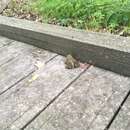Description
provided by AmphibiaWeb articles
The body length of this toad is usually between the range of 1 1/2"-3 1/4" (3.7-8.3 cm). Generally brownish, greenish to light gray above. It has a whitish stripe down the back and dark spots with reddish warts. Two prominent tubercles on the hind feet assist in burrowing. Males tend to have a dark-colored throat (Stebbins 2003).
- Alberta Government (2002). Amphibians of Alberta. Crown Copywrite, http://www3.gov.ab.ca/srd/fw/amphib/ct.html.
- Blackburn, L., Nanjappa, P., and Lannoo, M. J. (2001). An Atlas of the Distribution of U.S. Amphibians. Ball State University, Muncie, Indiana.
- Greeen, D.M., and Pustowka, C. (1997). ''Correlated morphological and allozyme variation in the hybridizing toads Bufo americanus and Bufo hemiophrys.'' Herpetologica, 53, 218-228.
- Hamilton, I.M., Skilnick, J.L., Troughton, H., Anothony, P., Russell, G., and Powell, L. (1998). ''Status of the Canadian Toad (Bufo hemiophrys) in Alberta.'' Alberta Environmental Protection, Wildlife Management Division, and the Alberta Conservation Association, 12, 8-21.
Distribution and Habitat
provided by AmphibiaWeb articles
Anaxyrus hemiophrys inhabits several regions in Canada and the United States as well. In Canada, these toads occur in Alberta, Manitoba, Northwest Territories, and Saskatchewan. In the United States, they are found in Minnesota, Montana, North Dakota, South Dakota, and Wyoming (Blackburn 2001). A. hemiophrys occurs in grassland, ponds, potholes, lakes, aspen parkland, streams, areas with soft soil and along the range of the boreal forest regions. Habitat may have a very limited amount of vegetation, or even none at all (Hamilton 1998). Eggs are laid in the shallow water of lakes, ponds, quiet streams, marshes, potholes, and roadside ditches (Stebbins 2003).
Life History, Abundance, Activity, and Special Behaviors
provided by AmphibiaWeb articles
Anaxyrus hemiophrys is diurnal. During the night, it retires to sandy or vegetated areas, where it burrows in. However, it does become active during warm nights. This toad is active from late March to September (Stebbins 2003). It feeds on a variety of worms, beetles, and ants (Alberta Government 2002). Breeding season is from May to July, depending on the area. Breeding usually occurs in shallow areas of lakes, ponds or even temporary bodies of water. The female lays a single strand of eggs, totaling up to about 7000 eggs. Depending upon the temperature of the water, the eggs will hatch 3-12 days later (Alberta Government 2002). Canadian Toads have some defensive mechanisms to divert predators. When they are in danger, they increase their body size by inflating their bodies, or "play dead" when in immediate danger. Sometimes they startle their predators by crying loudly. They can also produce a thick white noxious secretion from the parotoid glands on the sides of their necks (Green 1997).
Life History, Abundance, Activity, and Special Behaviors
provided by AmphibiaWeb articles
Many factors are contributing to the decline of Anaxyrus hemiophrys, particularly loss of wetlands and possibly drought (Green 1997). Loss of breeding and hibernation habitat has also impacted this species (Hamilton 1998). Translocation efforts for Wyoming populations of A. hemiophrys failed (Trenham 2001).

